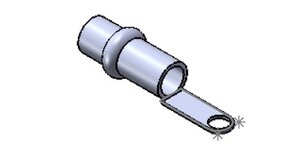Javert
Member level 2

I need something like a connector, in reality it is a tube, which has a diameter of 3 mm in the narrow part, 4 mm in the wide part and a height of about 25 mm.
In reality, it is made of 0.5 mm brass sheet. . The connector has a seam, the picture is only indicative.
I need a relatively large number of connectors and I would like to be able to manufacture them. Does anyone have experience with this?
I have an idea how it was originally produced
1. A 26 x 9.4 mm rectangle was cut out of the brass sheet
2. In the place of expansion, pressing creates a 5 mm wide, 0.5 mm deep recess
If I don't see a problem here, what I don't know is how to make a tube from a semi-finished product prepared in this way?
They could make it in the 50s, so should I.
I need about a hundred of them.
I am willing to invest time and money in the production / acquisition of the product, but I need to know how to do it

In reality, it is made of 0.5 mm brass sheet. . The connector has a seam, the picture is only indicative.
I need a relatively large number of connectors and I would like to be able to manufacture them. Does anyone have experience with this?
I have an idea how it was originally produced
1. A 26 x 9.4 mm rectangle was cut out of the brass sheet
2. In the place of expansion, pressing creates a 5 mm wide, 0.5 mm deep recess
If I don't see a problem here, what I don't know is how to make a tube from a semi-finished product prepared in this way?
They could make it in the 50s, so should I.
I need about a hundred of them.
I am willing to invest time and money in the production / acquisition of the product, but I need to know how to do it




